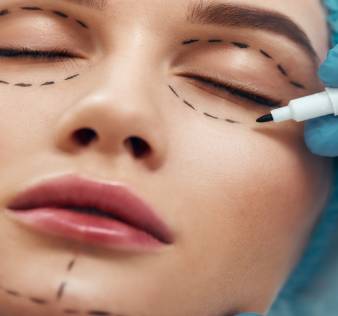
Facelift- HIFU-ULTHERAPY
Reinvent your youth with a facelift surgery by Dr. Saraswat
Gravity, exposure to sun, and stress can lead to the formation of ageing signs on the face. The onset of ageing brings in cell and an extra cellular matrix loss, which requires the restoration of volume as a perfect solution.
The changing contours of face
The right patient for a facelift
People with sagging face and neck but with skin that has some elasticity and a well-defined bone structure can be the right candidates for a facelift. Generally, the patients are between the ages of forty to sixty, although a facelift can be performed on people in their seventies or eighties too, given that there are no underlying medical conditions.
What facelift does to a face
A facelift improves the very visible signs of ageing by removing the bulging fat, tightening the underlying muscles and redraping the skin. It, by no means, claims to completely stop the normal ageing process. A facelift can be done as a stand-alone or in combination with multiple procedures such as a browlift, blepharoplasty or rhinoplasty.
A facelift strokes liveliness and freshness on a face. It can boost self-confidence and self-image. It, however, does not provide you a different look or bring back the health and vitality of youth. A person must have his/her expectations clear, and may even talk to the surgeon, Dr. Saraswat in this case, before signing up for surgery.
A handy list of facelift facts
The other risks might include:
Sides to facelift surgery
EYES: An increase in age triggers fat accumulation around the eyes. Excess skin and fat bring in a feeling of heaviness around the eyes. One might even find it difficult to keep his/her eyes open. Bags appear on the lower eyelids, which give out an appearance of tiredness.
Blepharoplasty and cosmetic eye surgery can enhance the look around your eyes.
FOREHEAD: Expression lines or other signs of ageing in the forehead region can be treated with a forehead or brow lift. The brow lift raises the eyebrows and smoothens the forehead giving a relaxed and attentive look.
CHEMICAL PEEL: In this cosmetic procedure, damaged or aged layers of skin are removed to reveal the newer and softer skin underneath. It treats wrinkles, facial blemishes, skin pigmentation, and melasma (pregnancy marks). The process utilizes Alpha Hydroxy Acids (AHAs), Trichloroacetic Acid (TCA), and Argipee.
Types of facelift surgeries conducted by Dr. Saraswat
MACS LIFT: The brainchild of Patrick Tonnard and Alex Verpaele from Belgium, MACS or Minimal Access Cranial Suspension technique offers skin rejuvenation like that of a facelift, only with less invasive surgery and a smaller scar. Dr Satya Saraswat attended the CATFAS V (Controversies, Art and Technology in Facial Aesthetic Surgery) meet that had taken place at Ghent, Belgium and was organised by Patrick Tonnard and Alex Verpaele.
TRADITIONAL FACELIFT: A surgical method of facelift that involves giving subtle incisions right in front of the ears in a way that it remains barely noticeable. The SMAS (Sub Musculo Aponeurotic System) is either stiffened by the SMAS fold or re-sectioned (SMAS Resection), after lifting the facial skin.
MENDELSON FACELIFT: A technologically advanced technique crafted by Dr Bryan Mendelson from Australia that treats the loose space of face to give it a more youthful look. Although it is more challenging than the traditional facelift technique, it involves minimal distortion or the tightening of facial layers. Thus, it radiates a more natural and fresher look. Dr. Saraswat had attended a Master class in this technique conducted by Dr. Byran Mendelson at the 23rd ISAPS World Congress held at Kyoto, Japan, from 24th to 27th October 2016.
MIDFACE LIFT: The loss of skin elasticity and the sagging of cheeks and eyes appear with ageing and give out tired vibes. The mid-facelift or cheek lift restores the natural shape of your lower eyelids and cheeks. It corrects any puffiness or bags under the eyes, hollowness in the upper cheeks and prominent nasal folds. This surgical facelift leaves a natural and radiant appearance, and nothing looks overdone.
Ancillary Procedures with Face Lift- Other procedures like Neck Lift, Nano fat Grafting, Blepharoplasty, Rhinoplasty, Browlift, and Chin Implant can be combined with facelift surgery to achieve overall rejuvenation. Dr. Saraswat offers not only a graded facelift but blue-ribbon facial rejuvenation surgeries to patients worldwide as well.
Adipose-Derived Stem Cells (ADSCs): Current Findings and Future Perspectives in Structural Facial Fat Grafting
BENEFITS OF ADSC
The world of plastic surgery not only recognises degeneration as a key sign in facial ageing but also refers to the descent of fat. Nowadays, gravitational ageing has been made a prime target of conventional aesthetic surgeries. This argument of gravity has successfully birthed surgeries like a facelift, brow lift, eyelid correction and laser skin resurfacing to reverse ageing.
Procedures such as these are based on removing and lifting the excessive, abundant and descended tissues. Unfortunately, there are no animal models for gravitational ageing. The degree of sagging and age-related fibrosis that counteract increased laxity, vary to a great extent among individuals.
Looking at the results of our efforts to rejuvenate the face, we can conclude that fat removal based surgery is not an answer to total facial rejuvenation. A well-performed facelift surgery may produce an unnatural result instead of a naturally fresh looking rejuvenated appearance. There is more to restoring a youthful look than what faceliting does.
Fat grafting has gained prominence in recent years. Its importance in clinical practice appeared due to the possible applications in reconstructive, trauma, and aesthetic surgery. Recently, Dr. Saraswat began transferring stem cells, the Adipose-derived stem cells (ADSCs) as a part of facelift.
BENEFITS OF STEM CELLS IN FAT TRANSFER
Post Facelift – Aging and Rejuvenation